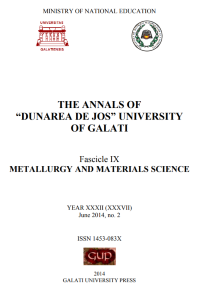Improving Biocompatibility of Co-Cr Alloy Used in Dentistry by Surface Modification with Electrochemical Methods – Corrosion of Untreated Co-Cr Alloy in Solution with Different pH
Abstract
The use of metals and alloys in dentistry has seen remarkable progress due to the deep research on their biocompatibility or the application of advanced technologies to improve surface properties by controlling material/environment interactions occurring in the mouth. The biocompatibility of metals and alloys is a consequence of the presence of the surface oxide layer. The chemical properties and therefore the interface chemical processes are determined precisely by this oxide layer and not the metal itself. The material response to changes in pH, to the application of force or the degrading effects of fluids may impair biocompatibility. Corrosion resistance, an important feature of the biocompatibility, can be verified by studying the electrochemical behaviour of metals and alloys in specific environments. This paper presents some research results on the corrosion behaviour of Co-Cr biomaterial composition in aqueous solutions with different pH (Fusayama - Meyer artificial saliva, Hank’ s and Ringer’ s solutions, citric acid) given that many of chemical reactions in the mouth are extremely sensitive to the environmental pH. The electrochemical methods used (free potential, potentiodynamic curves and cyclic polarization) are relevant methods for studying interactions of materials - specific environment of use/exploitation. Research has shown different behaviour of the alloy according to the pH, the chloride content and the oxidizing nature of the environment.
Downloads
References
[2]. K.-H. Frosch, K. M. Stürmer - Metallic Biomaterials in Skeletal Repair, European Journal of Trauma, 2, 2006, p. 149-159.
[3]. J. Alvarado, R. Maldonado, J. Marxuach, R. Otero - Biomechanics of hip and knee prostheses, Mech., Mater.–I, INGE, 4011, 1, 2003, p. 1-17.
[4]. M. Navarro, A. Michiardi, O. Castaño, J.A Planell - Biomaterials in orthopaedics, J. R. Soc. Interface, 5, 2008, p. 1137-1158.
[5]. J. J. Ramsden, D. M. Allen, D. J. Stephenson, J. R. Alcock, G. N. Peggs, G. Fuller, G. Goch - The Design and Manufacture of Biomedical Surfaces, CIRP Annals-Manufacturing Technology, 56, 2007, p. 687-711.
[6]. R. Zupančič, A. Legat, N. Funduk - Electrochemical and mechanical properties of cobalt-chromium dental alloy joints, Materiali in tehnologije/Materials and technology Mater. Tehnol., 41, 2007, p. 295-300.
[7]. Y. S. Li, K. Wang, P. He P., B. X. Huang, P. Kovacs - Surface - enhanced Raman Spectroelectrochemical Studies of Corrosion Films on Implant Co-Cr-Mo Alloy in Biosimulating Solutions, J Raman Spectrosc, 30, 1999, p. 97-103.
[8]. L. Benea, E. Mardare-Danaila, M. Mardare, J.-P. Celis - Preparation of titanium oxide and hydroxyapatite on Ti–6Al–4V alloy surface and electrochemical behaviour in bio-simulated fluid solution, Corrosion Science, 80, 2014, p. 331-338.



